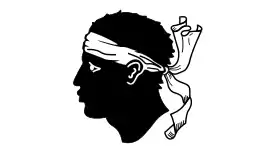Unione Corse
The Unione Corse is a Corsican mafia criminal organization operating primarily out of Corsica and Marseille, France. Members of this organization, along with various other crime families, maintained the French Connection–a heroin trade monopoly between France and the United States from 1930 to 1970.
 The Unione Corse controversially use the same symbolism as the flag and coat of arms of Corsica. | |
| Founded | 1920s |
|---|---|
| Founding location | Marseille, France |
| Years active | 1920s–present |
| Territory | France (mainly Corsica and Provence-Alpes-Côte d'Azur) |
| Ethnicity | Corsican and Italian French |
| Criminal activities | Racketeering, drug trafficking, gambling, extortion, robbery, loan sharking, weapons trafficking, pimping, fraud, murder, bribery and fencing |
| Allies | American Mafia Sicilian Mafia Camorra |
Symbol
The symbol of the Unione Corse is the same as the symbol for Corsica, the Maure, or Moor's Head, a depiction of a black human head with a rag tied around the forehead, on a white field. A member of this society may wear it as a pendant or a watch fob.[1]:2
Heroin trade
The Unione Corse started to get involved in the drug trade in South-East Asia in the 1930s and by the 1940s was heavily involved; in 1954 after the French retreat from Indochina, Corsican mobsters flew drugs from Laos into South Vietnam by plane. The operations were collectively known as "Air Opium". Between the 1930s and 1970s, they smuggled heroin refined in Marseilles to New York; the Unione Corse's involvement in the heroin trade was what became known as the infamous French Connection. Ultimately, international cooperation between law enforcement agencies dismantled the operation.
Relationship with the French government
The Unione Corse has enjoyed some degree of influence within French government and law enforcement. During World War II, the Unione Corse had a schism with some favoring Vichy and the Germans. The Free French sympathizers within the milieu pacified and rendered harmless several prominent German sympathisers in Marseilles on behalf of the French Resistance.
In 1948, the Unione Corse was enlisted to act as strikebreakers in Marseilles; the society provided assistance in the form of longshoremen to unload ships and to persuade unions to return to work. Some Unione Corse members hold elected office; there are others in the Gendarmerie Nationale, Douanes France and SDECE.
It is believed that this close, mutually beneficial relationship has prompted the Government of France to somewhat de-emphasise law enforcement in regards to this group with political corruption, white-collar crime and tax avoidance / tax evasion and control of football clubs, casino, hotel nightclub management being on the "business" side of the spectrum of the criminal activities.
Criminal activities
Numerous forms of racketeering, aside from the above-mentioned drug trafficking and money laundering, extortion, prostitution, robbery and contract killing have been suggested.
Characteristic example
Typical of the Unione Corse's secrecy would be the case of a man known as Antoine Rinieri.[1] On 12 June 1962, Rinieri, who identified as an art broker, arrived in the City of New York by air from Paris, France, carrying $247,000 in hard currency, ostensibly to purchase an object of art from an American identified as "Mr. Anderson". He arrived at a club to complete the purchase, but the seller was a no-show; Rinieri decided to visit a friend, Gennett, in Asheville, North Carolina, before he left for Europe. For the duration of his visit, the money was stored in a jointly held safety deposit box at Wachovia Bank in Asheville, per the recommendation of Gennett. On 18 June, Rinieri left Gennett, flew to Chicago, and there boarded an aircraft which was to fly to Zürich via Montréal. The flight was rerouted to New York, where Rinieri was arrested and questioned.[2]
At its conclusion, Rinieri was served with a notice to appear before a federal grand jury. At the proceedings, he refused to identify the American from whom he intended to purchase art, and refused to identify a Swiss acquaintance in temporary possession of the money prior to Rinieri's entry into the US, on grounds of a "code of [business] ethics" and a desire not to violate "confidential relationships". Rinieri declined to rely upon the Fifth Amendment to the Constitution of the United States.[3]
The prosecution alleged that "unnamed agents of the Bureau of Narcotics 'believe' these funds represent the proceeds from the sale of narcotics in the United States by"[2] Rinieri. He was sentenced to incarceration for a term of six months for contempt of court, after which he was flown back to France. During this time, no link was, or could be, established between his money and undocumented trade in narcotics; the money was paid back with interest.
Notable members
Like the Mafia, the Unione Corse is also split into separate crime families. The Unione Corse is alleged to be far more secretive and tightly knit than the Mafia, and law enforcement have found it hard to extract information from members, who follow a code of silence similar to the Sicilian Omertà. Family ties create bonds between the members, which are not only stronger but allow protection against outsiders trying to either infiltrate or gather information about any of the members.[1] As of the early 1970s, there were around 15 clans operating in France, the most notorious being the Francisci, including Marcel Francisci, the Guerini brothers, including Antoine Guérini, the Orsini, and the Venturi including Dominique Venturi, aside from Paul Carbone, Lucien Conein, Lucien Sarti and Paul Mondoloni.[1]
Notes
- "The Milieu of the Corsican Godfathers". Time. 4 September 1972. Archived from the original on 31 May 2008.
- "Rinieri v. Scanlon". 20 April 1966. Retrieved 13 October 2013.
- "United States of America, Appellee, v. Antoine B. Rinieri, Defendant-Appellant., 308 F.2d 24 (2nd Cir. 1962)". Retrieved 13 October 2013.